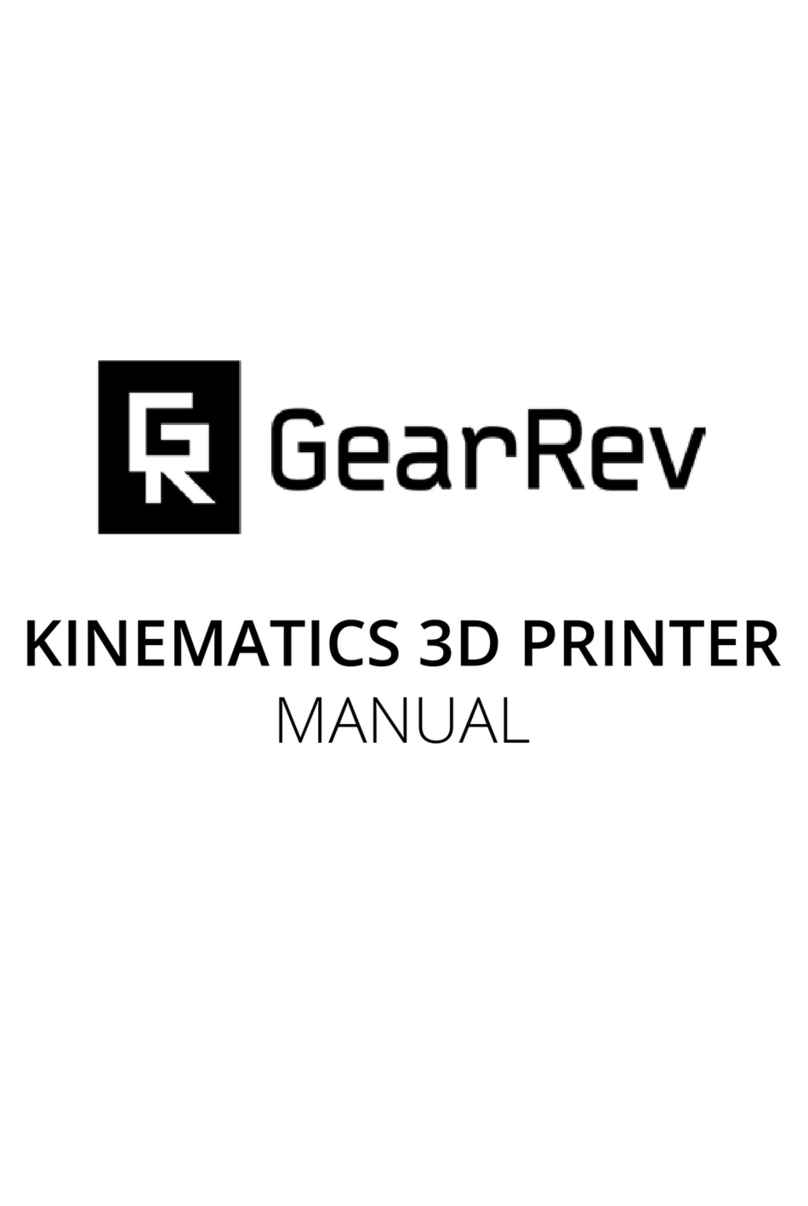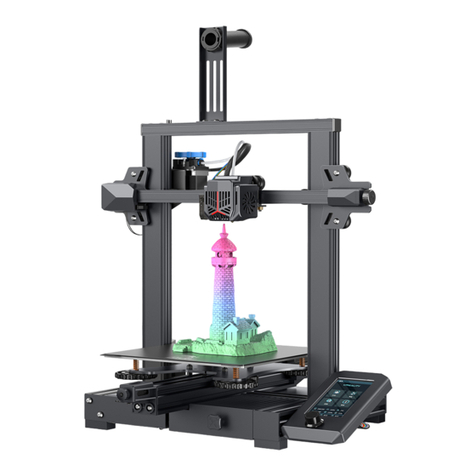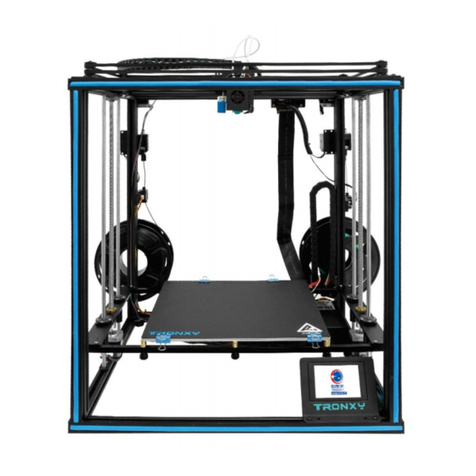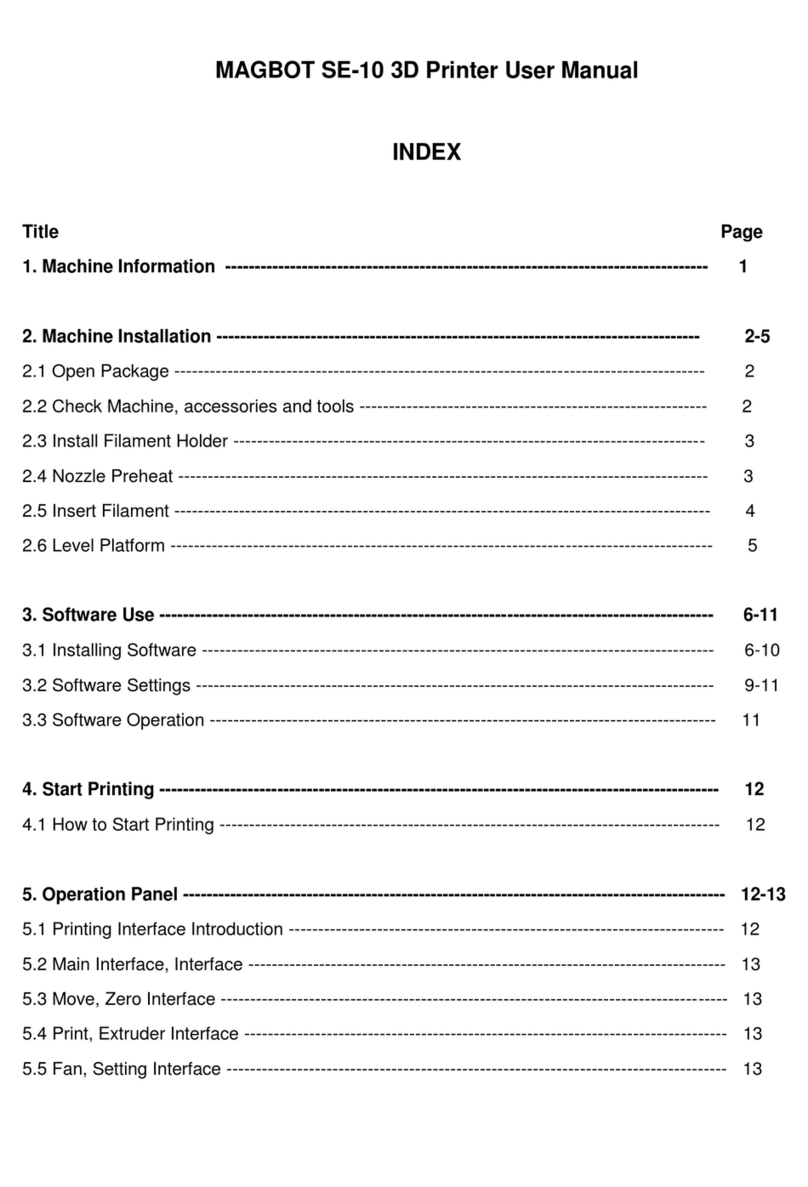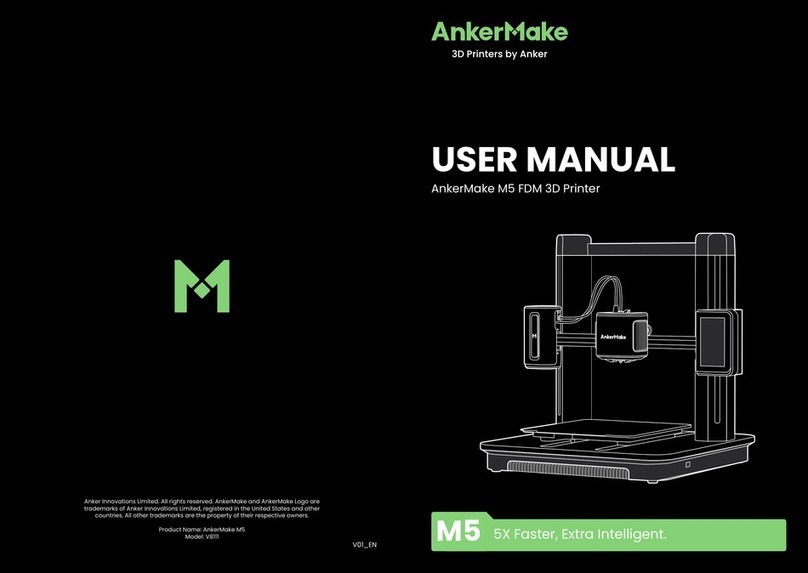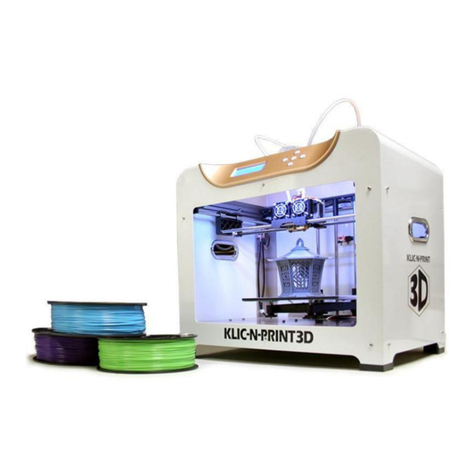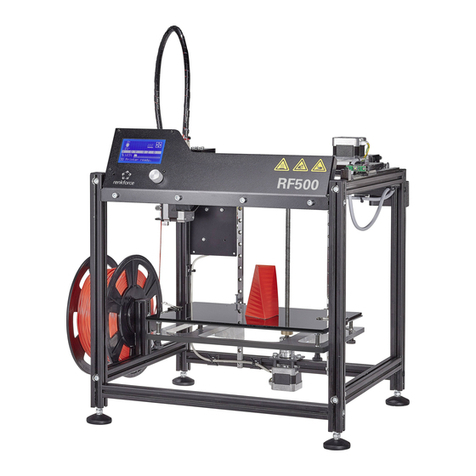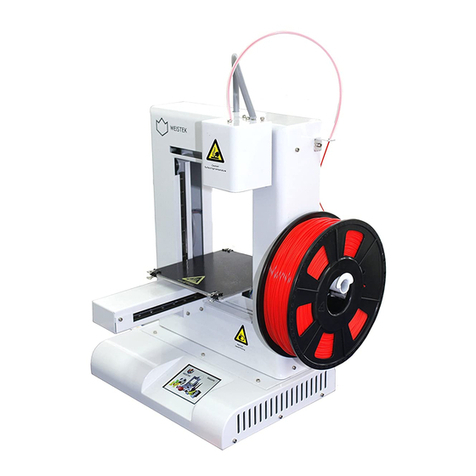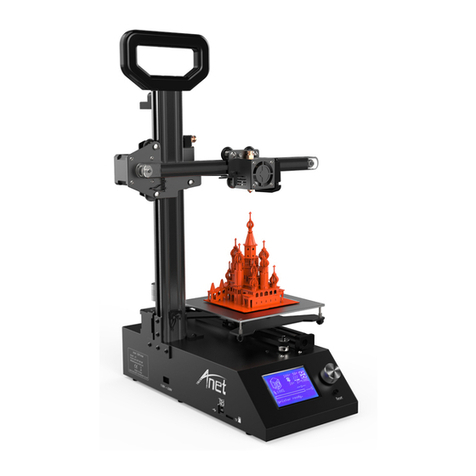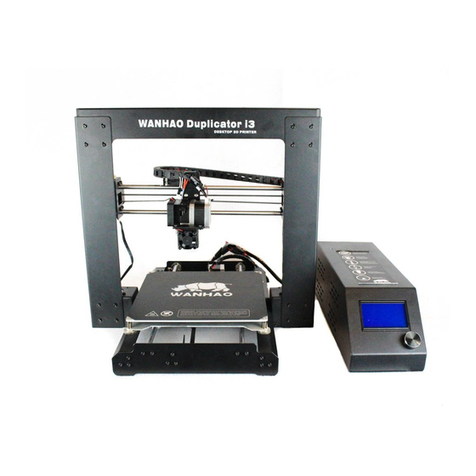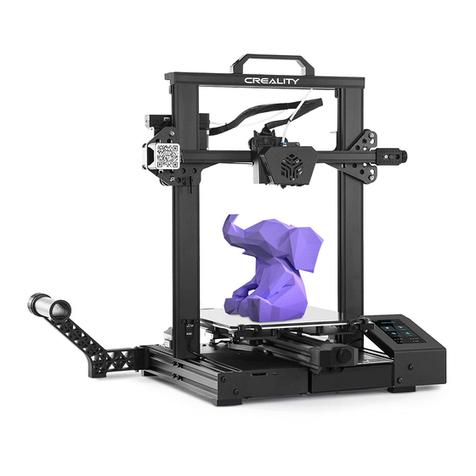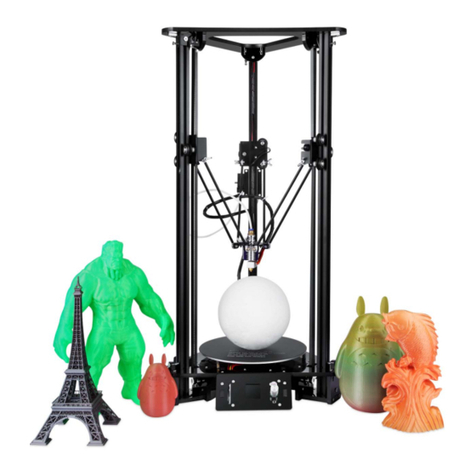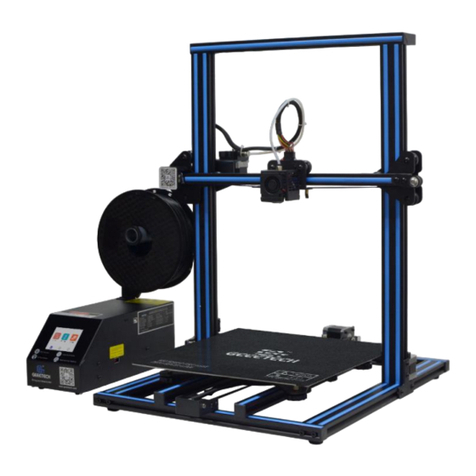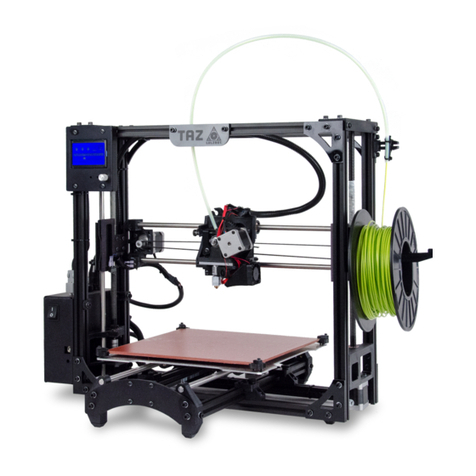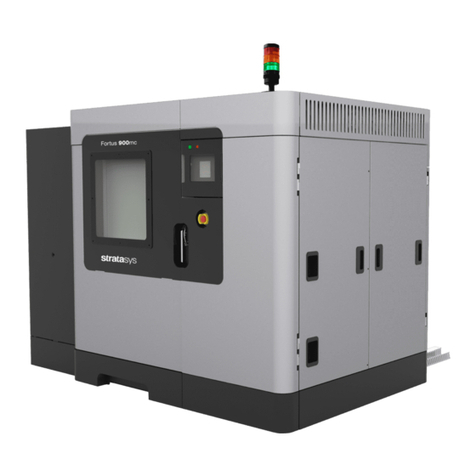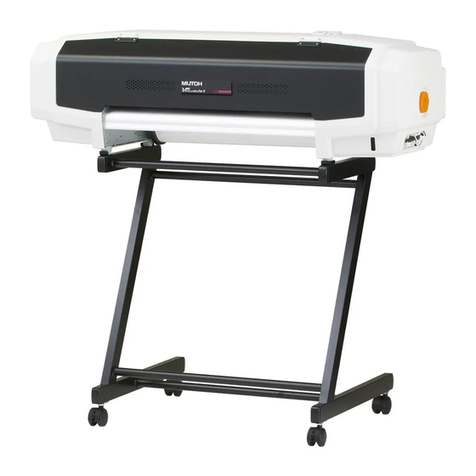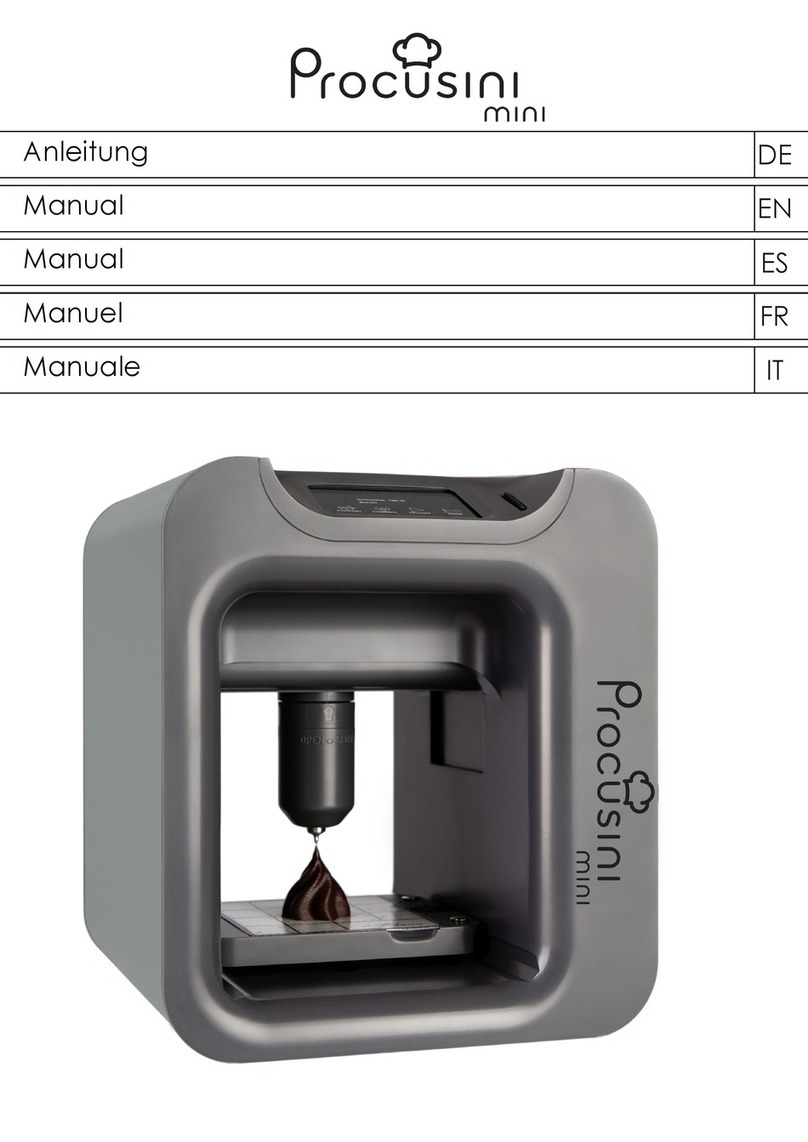GearRev Kinematics User manual

KINEMATICS 3D PRINTER
MANUAL

3

4 5
CONTENTS
TOOLS NEEDED FOR ASSEMBLY 5
ASSEMBLY OF THE TOP VORTEX 7
ASSEMBLY OF THE BOTTOM VERTEX 10
ASSEMBLY OF AXIS MOTORS 12
ASSEMBLY OF LONG LONG V RAILS 15
ASSEMBLY OF THE EFFECTOR 19
ASSEMBLY OF THE BELT CONNECTOR PIECES 24
ASSEMBLY OF TOP VERTEX ON THE FRAME 27
ASSEMBLY OF THE BELT 28
ASSEMBLY OF THE FILAMENT EXTRUDER 30
ASSEMBLY OF THE LCD SCREEN 33
ASSEMBLY AND WIRING OF MAKE BOARD 35
WIRING OF THE AXIS MOTORS & LIMIT SWITCHES 36
ASSEMBLY OF THE PRINT PLATFORM 38
POWER SUPPLY 40
MAKEBOARD OUTLET COVER AND FILAMENT HOLDER 41
TOOLS NEEDED FOR ASSEMBLY
Materials
2.5mm allen key
2mm allen key
1.5mm allen key
Mini athead screwdriver
Phillips head screwdriver (not included)

6 7
REFERENCE PAGE FOR PARTS ASSEMBLY OF THE TOP VORTEX
Step 1
Take a top vertex. The side having the hex-
agonal groove in the center is on the bot-
tom. (See gure 1.1).
Then attach M4*10 screws into the 4 holes
in the ank from the inside, As well as the
back hole of the Vertex .
After that, put on the M4 square nuts from
the outside (attention: only turning nut ap-
proximately 3 times, they should be loose.)
(As gure 1.2)
Repeat this step for the remaining vertexes.
Figure 1.1
Figure 1.2
Materials needed for assembly
Short V rails (3)
Top vertex (3)
M4 Square nut (12)
M4*10 screw (12)
This ller head
is at the top Hexagonal groove
side at bottom
1
2
3
4
M2.5*16mm screw
M3*20mm screw
M3*12mm screw
M3*8mm screw
M4*25mm screw
M4*30mm screw
M4*10mm screw
M4*8mm screw
M3 wing nut
M3 nut
M4 nut
Washer
T type nut
M4 square nut
Small spring
M4 copper spacer
NOTE: M4 T nuts were used instead of M4
square nuts in the gure below. Although they
are interchangeable, please follow the instruc-
tions and use M4 square nuts instead.

8 9
Step 2
Lay the top vertex on a at surface. The side
with the hexagonal groove being on bot-
tom. Slide short short V rail in the ank of
the vertex. (These should easily slide on due
to the screws being loose).
Using the M2.5 Allen Key fasten the screws
tightly from the inside. (As gure 1.4).
Figure 1.3
Figure 1.4
Step 3
Next, assemble the remaining top Vertexes
with the short V rail, similar to steps 1 & 2.
Attention: the bottom of the vertex is the
side with hexagonal grooves. (As gure 1.4)
Step 4
Sequence 3 assembled top Vertexes like
Figure 1.5, then put them together slowly.
Finally, tighten the remaining screws.
Figure 1.5
Step 5
Install the 608 bearing as per Figure 1.6.
Hold the vertex upright to assist alignment
of the M3 nut on top of the 608 Bearing.
Next, place the M3*20 screw under the 608
Bearing using the Allen key to tighten.
Repeat step for the remaining 2 sides to
complete. (Figure 1.7)
NOTE: Do not overtighten the assembly. Make
sure the bearing is secure but also rotating
smoothly.
Figure 1.6
Figure 1.7
Materials needed for assembly
M3 nut (3)
M3*20 screw (3)
608 Bearing (3) M3 nut
608 bearing

10 11
ASSEMBLY OF THE BOTTOM VERTEX
Materials needed for assembly
M4*10 screws (30)
M4 square nuts (32)
M4*8 screws (2)
Short V rail (6)
Makeboard (1)
Bottom vertex (3)
Step 1
The bottom Vertex is assembled similar as
the top Vertex.
Attach 10 pairs of M4*10 screws and M4
square nuts on all 3 Vertexes. 8 pairs on the
ank and 2 pairs on the back. (Fig 1.8)
Figure 1.8
Small hole on
vertex at bottom
for future wires.
2 Groups of
screws and nuts
4 Groups of
screws and nuts
Step 2
Before sliding together the short V rails,
attach the Makeboard to one of the short
V rails using 2 M4*8 screws and M4 square
nuts. Make sure the mounting holes on the
side of the USB input are used to mount the
Makeboard (See Figure 1.9).
Figure 1.9
Step 3
Assemble the short V rails to the 3 bottom
Vertexes just like the top Vertex. Be sure
the Makeboard connection holes are facing
outwards (i.e away from the center of the
vertexes), and tighten the screws to secure.
(Figure 1.10)
The makeboard should sit between the V
rails.
Figure 1.10
Figure 1.11
NOTE: M4 T nuts were used instead of M4
square nuts in the gure below. Although they
are interchangeable, please follow the instruc-
tions and use M4 square nuts instead.
NOTE: The small hole on each of the vertices
designates the bottom of the vertex. Ensure
that the orientation of the hole is the same for
all 3 vertices.
NOTE: The small hole on each of the vertice
designates the bottom of the vertex. Ensure
that the orientation of the hole is the same for
all 3 vertices.
Make sure that the vrails are ush with the
bottom vertice.

12 13
ASSEMBLY OF AXIS MOTORS
Materials needed for assembly
Timing wheel (3)
Axis stepper motor (3)
M3*8 screws (12)
Step 1
Take a stepper motor and place a timing
wheel on the shaft of the motor.
Figure 2.0
Step 2
The set screw of the stepper gear should
correspond with the at groove on the mo-
tor shaft (see gure 2.1)
The set screw is already included in the tim-
ing wheel.
Figure 2.1
Stepper motor
Set screw
Flat groove
Stepper gear
Step 3
Tighten the set screw of the timing wheel
using a 1.5mm allen key so it is secured at
the base of the groove in the shaft (i.e there
should be a 3mm distance between the top
of the stepper motor shaft and the stepper
gear).
Ensure that the set screw is tight. GearRev
recommends the application of thread lock
on the set screws.
Step 4
Repeat steps for the 2 remaining axis step-
per motors.
Step 5
Attach stepper motor to the bottom vertex
with the wires facing down.
To start, position the stepper motor in the
vertex as seen in gure 2.2.
Figure 2.2
groove for
Allen key
screw in each
corner
Make sure to use the non-ball end of the 1.5mm allen key
to tighten the set screw. This step is very important as a loose
timing wheel may lead to slippage in future operation.

14 15
Step 6
Position 4 M3*8 screws in the coordinating
holes and begin to screw manually rst to
avoid damage to motor.
Step 7
Use a 2.5 allen key against the grooves in
vertex to tighten the M3*8 screws to secure
the stepper motor in place.
Step 8
Repeat steps for the two remaining 2 step-
per motors.
ASSEMBLY OF LONG LONG V RAILS
Materials needed for assembly
Long V rails (3)
Terminal block (3)
limit switches (3)
M4 square nut (3)
M4*10 screw (3)
M2.5*16 screw (6)
Step 1
Assembly of Limit switches
Tighten the M4 square nut with the M4*10
screw in the grove of the terminal block
(3.1)
Attach the limit switch to the terminal block
by screwing 2 M2.5*16 screws in their cor-
responding holes (3.2) (attention, not too
tightly to damage spring inside).
Repeat step for remaining 2 limit switches.
Figure 3.1
Figure 3.2
Terminal Block Limit Switch
M4*10 screw
& M4 nut

16 17
Step 2
Long V rails
Insert three 2020*680mm long V rails to
their corresponding slots in the bottom
vertex.
Once in place, tighten the M4 screws to se-
cure long V rails. (Figure 3.3)
Figure 3.3
Step 3
Wiring
Next, slide the wire attached to the limit
switch down the hole of the Long V rail and
guide the wire through the hole in the ver-
tex (Figure 3.4 & 3.5)
Repeat for remaining long V rails.
Figure 3.4
Figure 3.5
M4*10 screw
& M4 nut
Hole at bottom
of vertex
Step 4
Linear rails
Assemble the three linear rails with sliders
by attaching 4 M3*8 screws and 4 M3 T nuts
to each rail (Figure 3.6).
Place screws on holes 1, 7, 12, & 18 of the
linear rail. (See Figure 3.7)
Be sure to leave the screws and nuts loose
for easy attachment to the long V rail. Figure 3.6
Figure 3.7
Insert screws
into holes
# 1, 7, 12, 17 7
1
12
18
Hole on top of
V rail

18 19
Step 5
Secure
Slide the linear rails onto the long V rail
grooves, securing them temporarily while
we attach the limit switch in place.
Secure the limit switch 5cm below the top of
the V rail groove (see gure 3.9)
Slide the linear rails up, securing them right
below the limit switch (See gure 3.8).
Figure 3.9
Figure 3.8
ASSEMBLY OF THE EFFECTOR
Step 1
Print Head
Assemble the print head with the heating
rod by inserting the heating rod and tem-
perature head into the two corresponding
holes of the heating aluminum block (See
gure 4.1). The set screw under the heating
block may need to be loosened in order to
insert the heating rod and the thermistor.
The ends of the heating rod should be sym-
metrical on either side of the hole. Make
sure the thermistor is inserted well into its
designated hole.
Secure in place by tightening the set screw
with a 1.5mm allen key. Be gentle to not
damage the wire inside.
Figure 4.1
Figure 4.2
Materials needed for assembly
The auto-alignment eector user materials
M2.5*16 screw (2)
M3*12 screw (9)
M3*8 screw (2)
M3*20 screw (1)
M4*30 screw (1)
Spring (1)
M3 nut (2)
M4 nut (1)
endstop (1)
Temperature
head
Heating rod
Hole for
heating rod
Hole for
temperature head
Heating rod has
symmetrical distance
on both sides
Set screw
Assembled nozzle (1)
Heating wire (1)
2 pin connector (1)
Figure 3.10

20 21
Step 2
Limit switch
Insert the limit switch wires into the big hole
of the external part
to secure, install 2 M2.5*16 screws in the
remaining holes of the external part (see
gure 4.4)
Cover the end of the limit switch wire into
the 2 pin connector. Ensure that the wire is
locked into place. There should be a subtle
click once the wire is locked into place (See
gure 4.5).
Figure 4.3
Figure 4.4
Figure 4.5
Figure 4.4
External
Part
Small
spring
M2.5*16
screws
Limit
Switch
Fan
Groove
Jig of Print
Head
Internal
Part
Hole for
limit switch
wires
M2.5*16
screws
Step 3
External part
Cover the assembled nozzle with the inter-
nal part and place it inside the external part
with the wires coming out of the back end,
opposite to the limit switch. (Figure 4.7).
Cover the assembled nozzle with the with
the internal part (Figure 4.6)
Secure this assembly by attaching with the
jig of the print head to the internal part with
2 M3*12 screws and 2 M3 nuts (Figure 4.8)
In addition, add the M4*30 screw and the
M4 nut into the corresponding grooves in
the external part and turn approximately
4 times. (Note: the screw goes in the circu-
lar groove, and the nut in the hexagonal
groove, see Figure 4.9 & 5.1)
Figure 4.6
Figure 4.7
Figure 5.1
Figure 4.8
Figure 4.9
Wires
coming out
of the back
M3*12
screws
Internal part
M4 nut in
hexagonal
groove
M4*30 in
the circular
groove

22 23
Step 4
Fan groove
Add the fan groove to the bottom of the
external part using 2 M3*8 screws in the
corresponding holes (Figure 5.2)
Make sure the heatblock is not in contact
with the fan groove and is in the orienta-
tion shown in the gure relative to the fan
groove. Loosen the screws of the internal
part to rotate the print head into place if
needed.
Figure 5.2
Step 5
Small spring
Next, add the small spring to the shaft of
a M3*12 screw and insert into the big hole
of the external part above the limit switch.
And the M3*20 screw into the smaller hole.
NOTE: screw the M3*20 screw just enough
that the limit switch is triggered. (See gure
5.4)
When assembled properly, the limit switch
should be depressed by pushing up on
the assembled nozzle and triggered when
released.
Adjust both screws until the auto alignment
eector is working properly.
Figure 5.3
Figure 5.4
Heat block Fan groove
M3*12 screw and
spring
M3*20
screw
Step 6
Fans
Finally, add on two fans on either side of the
external eector, with the fan labels facing
inside.
Be sure to arrange the fans so the wires are
on the same side as the other wires (see
gure 5.5)
Mount the fans using 3 M3*12 screws to
their corresponding holes.
The fan above the fan groove will be the
“cooling fan”, opposite to the “radiating” fan.
Figure 5.5
Figure 5.6
radiating fan cooling
fan
M3*12 screws
M3*20 screw
M3*12 screw with spring
5.5)

24 25
ASSEMBLY OF THE BELT CONNECTOR PIECES
Materials needed for assembly
Carbon ber rods (6)
M3*25 screws (12)
M4 copper spacer (12)
M3 nuts (12)
Step 1
Carbon ber rods
On the bottom of the eecter, insert the M3
nuts into their corresponding holes.
Slide a carbon ber rod on the M3*25
screws.
Place M4 copper spacer on the M3*25
screws after the carbon ber rod and tight-
en the screws until secured into the nuts.
NOTE: Ensure that the copper spacers are
not sitting loosely in between the rod and
the eector as it can be the cause of un-
wanted noises upon printer activation (see
gure 5.7).
Repeat step for remaining sides.
Figure 5.8 shows the end result of this step.
Figure 5.7
Figure 5.8
M3 nuts
M4 copper spacer
Carbon ber rod
Step 2
Belt tensioner
Secure the belt tensioner on the opposite
end to the carbon bre rods similar to the
eector.
Place the M3 nuts in the corresponding
grooves on the back of the tensioner, se-
curing the copper rods with the M4 copper
spacer and M3*25 screws (see gure 5.9).
NOTE: Ensure that the copper spacers are
not sitting loosely in between the rod and
the tensioner as it can be the cause of un-
wanted noises upon printer activation.
Note the belt tensioner side with indenta-
tion should be facing opposite to the ef-
fector, and placed on parallel carbon bre
rods.
Repeat steps for remaining belt tensioners.
See gure 5.10 for how the nal assembly
should look like.
Make sure to have belt tensioners on par-
allel carbon bre rods for proper assembly.
(See gure 5.11)
Figure 5.9
Figure 5.10
M3 nuts in
grooves
Belt tensioner
M4 copper spacer
Grooves face
inward toward
eector
Indentation
faces opposite
to eector
Figure 5.11

26 27
Step 3
Attach tensioner to linear rail
Mount belt tensioner to the linear rail slider
by securing 4 M3*12 screws in their corre-
sponding holes (see gure 5.12)
Repeat steps for remaining belt tensioners.
Figure 5.12
Linear rail slider
ASSEMBLY OF TOP VERTEX ON THE FRAME
Step 1
Take the frame of the top vertex and loosely
attach a M4*10 screw and M4 square nut
on the corner of all 3 vertexes (see gure
6.1)
Slide frame onto the long V rails, aligning
the M4 square nuts with the long V rail
grooves and tighten screws to secure.
The hexagonal groove on the top vertex
should be pointing downwards.
Insert a M4*25 screw with a washer in the
top groove through to a M4 nut below and
tighten.
Do not overtighten the screw as to damage
the endstop wires.
Repeat for remaining sides of the vertex.
Figure 6.1
Figure 6.2
Figure 6.3
Materials needed for assembly
M4*25 screw (3)
M4 square nut (3)
Washer (3)
M4*10 screw (3)
M4*25 screw
with washer
M4 square nut
and M4*10
screw

28 29
ASSEMBLY OF THE BELT
Materials needed for assembly
450cm Belt (1)
Step 1
Divide and cut the belt into 3 equal parts
(Approximately 150 cm each)
Make a loop at one end of the belt
Loop it around the third chamber on the
belt tensioner as seen in Figure 7.1.
Next loop the other end around the timing
wheel (which is connected to the stepper
motor) (gure 7.2), and guide the belt up
through the other side of the belt tensioner
and around the 608 bearing of the top ver-
tex (gure 7.3).
Ensure that the belt is routed from the in-
side the carbon ber rods.
Figure 7.1
Figure 7.2
Figure 7.3
Chamber 1
Chamber 2
Chamber 3
Chamber 4
Figure 7.4
Figure 7.5
The other end of the belt will wrap around the
second chamber. Make sure the belt is tight
when securing it in. (See gure 7.4)
Finally install the belt spring to the belt to
ensure optimal tension. The belt springs will
need to be installed around 5 cm below the 4th
chamber of the belt tensioner. Use pliers for
this step if you have diculty installing the belt
spring.
Repeat steps for remaining belts.

30 31
ASSEMBLY OF THE FILAMENT EXTRUDER
Materials needed for assembly
Frame of the lament extruder (1)
Jig of the lament extruder (1)
Wing nut (1)
Bearing (1)
Extruder wheel (1)
Filament extruder (1)
Step 1
Extruder wheel
Place extruder wheel on the shaft of the
extruder motor, secure the wheel just at the
beginning of the groove on the shaft. Note:
the set screw securing the roll should be in
line with the groove (at part) on the shaft
(Figure 8.2).
Next, mount the frame on the Filament ex-
truder using 3 M3*8 screws.
Figure 8.2
Figure 8.1
Step 2
Jig of the lament feeder
Assemble the jig of the lament extrud-
er with the bearing located in the middle.
Secure the bearing in place using an M3*20
screw, washer and an M3 nut (see gure
8.3).
Secure the assembly to the frame using an
M3*20 screw (see gure 8.4)
Then place a M3 nut in the frame of the
Filament extruder and insert a M3*20 screw
into the jig to secure it closed with the wing
nut (Figure 8.5)
Figure 8.3
Figure 8.4
Step 3
Quick acting plug
To complete assembly, install a quick acting
plug on the left side corresponding hole
(gure 8.5)
Figure 8.5
Quick acting plug (1)
Extruder motor (1)
M3*20 screws (3)
M3 nut (1)
M3*8 screws (3)
PTFE tube (1)
Frame of the lament
extruder
Jig of the lament
extruder
Filament
extruder
Bearing
Extruder
motor
Set screw
Wing nut
M3*8 screws
Washer and
M3 Nut
M3*20
screws
M3*20
screw
Quick acting
plug
M3*20 screw
and wing nut
M3 nut

32 33
Step 4
Mounting and PTFE tube
Assemble 2 groups of M4*10 screws and
M4 t nuts to the holes of the ank.
Mount the Filament extruder assembly to
one of the long V rail grooves approximately
10cm below the top (See gure 8.6)
Attach the PTFE tube to the quick acting
plug hole, and the other end to hole on the
top the eector.
Figure 8.6
Step 5
Wrapping wires
Use the fan wire to wire connectors includ-
ed in the fan bag to attach the fans to their
respective cables.
Use the wrap around harness seen in gure
8.7, to cover all wires extending from the
eector. Covering the length of the wires.
Feed the group of wires (Including the auto
level endstop wire) between the bottom
vertexes, from the outside of the frame op-
posite of the make board. The LCD screen
will be placed on the remaining side, and be
considered the “front” of your printer.
Figure 8.7
ASSEMBLY OF THE LCD SCREEN
Materials needed for assembly
LCD screen (1)
LCD housing (1)
LCD clamps (2)
Knob toggle
M3*8 screw (4)
M4*10 screw (2)
M4 square nut (2)
Step 1
Slide the two clamps on either side of the
LCD screen.
Figure 9.2
Figure 9.1
Step 2
Place the housing over the LCD screen and
insert M3*8 screws into the 4 corners of the
housing to secure assembly (Figure 9.2)
PTFE tube end
M4*10
screws
PTFE tube end
Wire
connectors
LCD screen
LCD clamps
LCD housing knob
toggle
Clamps are placed in-
between screen and
housing and secured with
screws

34 35
Step 3
Use the toggle to cover the knob of the LCD
screen (gure 9.3)
Figure 9.3
Step 4
Clamp assembly on the bottom vertex and
secure with M4*10 screws and M4 square
nuts in the corresponding 2 holes.
ASSEMBLY AND WIRING OF MAKEBOARD
Step 1
Take the end wire of each axis limit switch,
and insert it into the 2 pin connector (gure
10.1).
Figure 10.1
M4*10 screws and nuts on
wither end of LCD screen
Step 2
Start assembly wiring with the eector
wires.
Strip away the ends of the heater wire if
needed.
Loosen the through hole screws labeled
“HEATER” on the makeboard and insert the
heater wires, securing the screws again
once in place (see gure 10.3)
Insert the fan wires into appropriate con-
nectors on the makeboard. Verify left and
right by tugging wires from the eector.
FanL corresponds to the cooling fan and
FanR corresponds to the radiating fan.
Complete the wiring of the eector by
inserting the thermH and autolevel limit
switch wire into their corresponding con-
nections on the makeboard.
The autolevel limit switch will correspond
with the connector labeled “autolevel” on
the make board.
Figure 10.2
Figure 10.3
Fan Left &
Fan Right
Auto level
(Limit switch) Therm H Heater
wires
Autolevel limit
switch
e end of the line is not pointing to "Autolevel" in
the gure.
Heater wires must be stripped to expose con-
ductive strand.

36 37
WIRING OF THE AXIS MOTORS & LIMIT
SWITCHES
Step 1
First, we must label the axis.
Having the makeboard at the base side of
the bottom vertex, we label the three axis
clockwise, Y axis, X axis, and Z axis. (See
gure 11.1)
Figure 11.1
Step 2 Step 2
Connect Motor wires
Place the appropriate motor wires from axis
Y, X and Z to their corresponding connectors
on the makeboard (see gure 11.2)
Note that the limit switch is labeled as the
“stop” on the makeboard.
Insert appropriate wire from the lament
extruder into the connector labeled E-motor
on the make board.
Use the remaining wrap around sleeve to
protect the extruder motor.
Figure 11.2
Axis X
Axis Y Axis Z
Makeboard at
bottom for wiring
The heated bed thermistor cables are
connected toTHERM B on the makeboard.
A 2 pin connector will need to be inserted
into the wires prior to connection.
White power cables of the heated bed
go into the HEATBED connector on
the makeboard. Strip the white wires if
needed.
The ends of
these lines
should point
to
their
respective
color
connectors
X-
motor
Y-
motor
Z-
motor
E-
motor
X-axis limit switch
Y-axis limit switch
Z-axis limit switch
Step 3
Connect LCD wires
Connect LCD wires EXP1 and EXP2 to their
corresponding connectors on the make-
board located beside the YXZ-axis stop
connectors in gure 11.3 (Conrm EXP wires
by looking at the back of the LCD and where
they lead to).
Heated Bed Wiring
Attach the two white power cables to the
Makeboard connectors labeled HEATBED
(loosen the screw, insert wire and then
secure by tightening screw again). This is
similar to step 1 of Assembling and Wiring
of Makeboard. Remaining wire (red/black)
is to be attached to Makeboard connector
labeled ThermB, which is beside ThermH.
Figure 11.3
EXP 1 EXP 2

38 39
ASSEMBLY OF THE PRINT PLATFORM
Materials needed for assembly
Bed clips (3)
Heated bed (1)
Glass plate (1)
M3*12 screws (3)
M3 T nuts (3)
Step 1
Print platform
Place the M3 t nuts in the vertex grooves in
preparation for the platform to be mounted
(1 nut on each vertex side) (Figure 12.1).
Cover the circuitry with the print platform
and with 2 M3*12 screws, secure the bed
clips to the bottom vertex like gure 12.2.
Figure 12.1
Figure 12.2
NOTE: The LCD clamps may need to be loosened to be able to mount the heated bed.to be able to
mount the heated bed
Glass platform Heated bed
POWER SUPPLY
Warning Do not power the PSU until wiring is completed.
Step 1
L port and N port
Start by loosening screws L and N (AC) on
the front of the power box (see gure 13.1)
From your outlet cord (AC cable), insert the
RED connector into the L port. and the BLUE
connector into the N port.
Tighten the screws to secure wires in place. Figure 13.1
Step 2
COM port and +V port
Next, loosen one COM screw and one +V
screw of your choice (see gure 13.2)
Take the DC cable and and insert the BLUE
connector into the COM port, and RED con-
nector into the +V port.
Tighten the screws to secure wires in place. Figure 13.2
DC
cable
AC
cable
Orange safety
guard
Step 3
Secure wires and safety guard
After securing all wires, close the orange
safety guard to cover the screws.
Before powering, conrm that the voltage
switch on the left side of the power box is
set to 110V (see gure 13.3) Figure 13.3
Voltage switch
Other manuals for Kinematics
1
Table of contents
Other GearRev 3D Printer manuals
